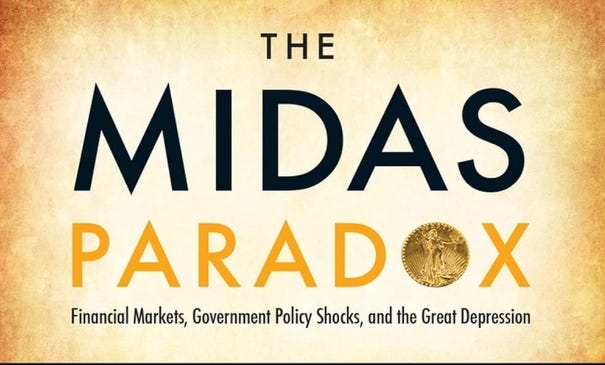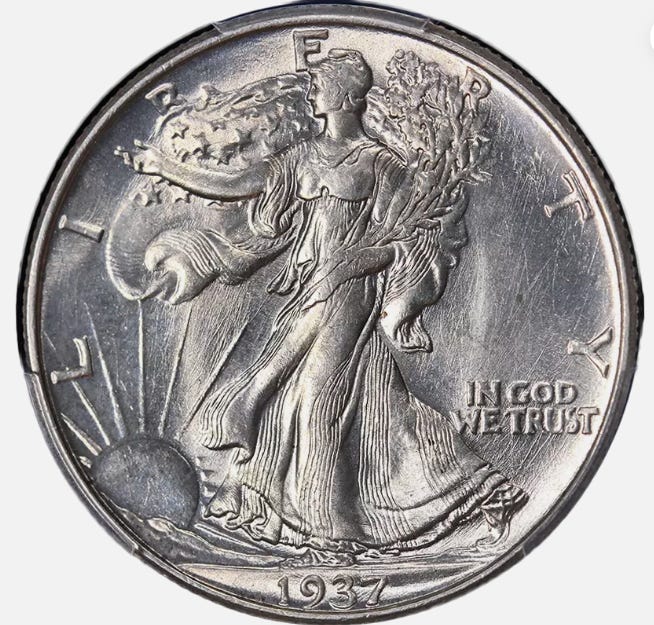Why not both?
The Great Depression: It's complicated
Most of my research career was focused on explaining the Great Depression. I suppose that The Midas Paradox is probably my best work, at least it's the publication I’m most proud of. (I foolishly let my publisher talk me out of calling it The Midas Curse.) I was recently thinking about how to explain my findings to people. Is there an elevator pitch?
In the end, it all seems too complicated for an elevator. But perhaps there’s a sort of unifying framing that helps make sense of the messy picture. I’ll attempt to provide that framing in this post. I’ll do so by showing that many aspects of the Great Depression are misunderstood because people are looking too hard for monocausal explanations. Economists often debate whether it’s X or Y, when in fact it’s both X and Y.
You can think about causality issues as being like peeling an onion. The exposure of one layer of causation reveals additional questions, in both directions. If X is important, then you need to know what caused X, and what were the effects of X.
The AS/AD framework is a good place to start. Was the Great Depression caused by a negative demand shock or a negative supply shock? Why not both? The initial contraction from August 1929 to March 1933 was mostly due to falling demand, as NGDP fell in half, white the excessively long and uneven recovery was partly caused by five adverse supply shocks.
Was the big decline in AD due to a falling money supply or an increase in gold demand? Why not both? When money is pegged to gold, the two media of account are like Siamese twins, joined at the hip. Where one goes, the other follows. In The Midas Paradox I found the gold market to be the more fruitful framework for studying aggregate demand, but the money supply approach is not wrong.
Is WWI the root cause of the Depression, or is the root cause the dysfunctional aspects of the (interwar) international gold standard? Why not both? If there had been no WWI, there would probably not have been a big depression after 1929, but it’s also true that if the world had switched to fiat money in 1913, WWI would probably not have led to a depression in 1929. (Just as there was no big depression after WWII.)
Are the Austrians right that the underlying problem was an excessively high price level (and NGDP) in the 1920s? Or are Keynesians and monetarists right that the key problem was an excessively low price level (and NGDP) in 1933? Why not both? It’s the sharp decline that matters. By early 1933, wholesale prices had roughly returned to their pre-WWI level. In a counterfactual where the immediate post-WWI inflation did not occur and the 1920s price level was much lower, a depression in 1929 might have been avoided. But there’s another alternative counterfactual where expansionary monetary policies maintained the elevated price level well past 1929.
Are the monetarists right that the key problem was a tight money policy by the Fed? Or are the gold standard theorists right that the key problem was French hoarding of gold? Why not both? The US and France were the two great gold hoarders of the interwar period. You can think of US gold hoarding either as a direct cause of the Depression, or as a factor that reduced the US (and global) money supply, depressing aggregate demand.
Did stocks crash in late 1929 because investors saw that tight money was pushing us into depression, or did the stock market crash because of Smoot-Hawley? Why not both? The onset of a sharp decline in NGDP in late 1929 was probably the major factor behind the October crash, but the political fight over Smoot-Hawley also played a role. (Tighter anti-trust enforcement and political problems in Germany may have also played a role.) The stock crash that occurred during the spring of 1930 was mostly Smoot-Hawley related.
Did Smoot-Hawley depress aggregate supply in 1930, or did it depress aggregate demand? Why not both? Smoot-Hawley led to a trade war that depressed output through supply side channels, but also indirectly led to a tighter monetary policy by depressing the equilibrium interest rate (and by reducing expectations of global monetary cooperation.) That’s why Smoot-Hawley caused commodity price indices to decline significantly in the spring of 1930 (whereas traditional trade models say tariffs are inflationary.)
Were the US banking crises that began in late 1930 a cause or a symptom of the Depression? Why not both? Sharply falling NGDP caused nominal debt defaults, and fear of additional bank failures caused currency hoarding.
Was the severe banking crisis of 1933 caused by fear of bank failures or by fear of dollar devaluation? Why not both? The former led to currency hoarding and the latter led to gold hoarding. Both assets were media of account, and thus both types of hoarding were contractionary.
Was FDR’s refusal to commit to the gold standard after the November 1932 election a positive or a negative for the economy? Why not both? His eventual decision to devalue was a huge positive. But his refusal to commit to the gold standard during the long interregnum (which in those days lasted until March) put Hoover in a difficult position. Distrust in the dollar undermined the US banking system and led to the worst 4 months in US economic history. Sorry Kant, FDR should have lied.
[Next year, George Selgin has a book coming out on the New Deal. Based on the blog posts it draws from, I expect it to be excellent.]
Did the US leave the gold standard in 1933, or did it remain on the gold standard until 1968? Why not both? After 1933, it was illegal for US citizens to own gold (except certain collectables.) Americans could not redeem dollars for gold. But until March 1968, gold remained pegged at roughly $35/ounce in places with free gold markets, such as Switzerland.
Was FDR’s first 100 days a success or a failure? Why not both? The policy of dollar depreciation led to the most rapid growth in US history, with industrial production soaring by 57% between March and July 1933. But his National Industrial Recovery Act forced nominal hourly wages up by roughly 20% in just two months after mid-July, and the recovery immediately aborted. Industrial production did not resume a sustained increase until after the Supreme Court declared the NIRA unconstitutional in mid-1935.
Was Keynes’s General Theory a response to the Fed’s failed open market purchase program during the spring of 1932? Or was it a response to FDR’s failed NIRA? Why not both? The failed OMPs created the (false) impression that monetary policy can get stuck in a liquidity trap at the zero lower bound (whereas the actual problem at that time was the constraints of the gold standard), while the NIRA created the (false) impression that market economies can get stuck in a low output equilibrium, even with flexible wages and prices. Much of the General Theory is based on those two misconceptions.
Was monetary policy exogenous or endogenous for individual countries under the international gold standard? Why not both? To some extent, interest rates, the money supply and the price level were all endogenous. On the other hand, individual central banks had some ability to affect global monetary conditions, by adjusting their gold reserve ratios. Even small countries like Belgium, the Netherlands and Switzerland were big gold hoarders, and had a non-trivial effect.
Was the 1937-38 “secondary depression” due to adverse supply shocks or adverse demand shocks? Why not both? A sharp rise in wages triggered by unionization drives enabled by the Wagner Act slowed the recovery in mid-1937. Higher reserve requirements and Treasury gold sterilization also played a role. Later in the year, a severe bout of gold hoarding associated with fear of dollar devaluation turned a mild recession into a deep slump.
Did war fears in Europe during the 1930s help or hurt the US economy? Why not both? War fears can lower the equilibrium rate of interest, which indirectly makes monetary policy tighter. But war fears also led to gold flows to the US, which were expansionary in effect.
Was Herbert Hoover a talented president or an inept president? Why not both? He was perhaps the most talented person to ever serve as president, and also one of the worst decision makers. (That’s probably telling us something important, but I’m not sure exactly what.)
And finally, an example to drive my critics crazy. The US did not produce any half dollar coins during 1930, 1931 or 1932. Was the lack of those beautiful coins a cause or consequence of the Great Depression? Why not both?
The US passively supplies coins to meet the demand of the public, given the stance of monetary policy. In that sense it was a consequence—the coins weren’t “needed”. But if monetary policymakers were told to adjust their policy stance in such a way that coin demand and hence production would have continued at a brisk pace during the early 1930s, then there would have been no Great Depression. In that counterfactual sense, the lack of newly produced coins did cause the Depression. In that sense, they were “needed”.
I don’t view either coin scarcity or the big plunge in M2 as a cause of the Depression, as coin production targeting and M2 targeting are not sensible policies. But it is true that adjusting the monetary base in such a way that M2 didn’t fall during the early 1930s would probably have prevented the Depression, as would a policy of adjusting the monetary base in such a way that coin production stayed at healthy levels.




Is it not strange that after all these years, we still have no "standard model" of macroeconomics that a super majority of economists understand and think is entirely useful, not to say "correct"?
Yes, yes, I know that in the world of theoretical physics debates rage and physicists disagree and egos are even larger than economists'. On the other hand, the standard model of physics is so useful it allows us to get to the moon and back, locate ourselves with GPS technology, and invent cell phones that take our pulses with LED radiation.
I'm half a decade older than you, Scott. You make way more sense of the macroeconomy than anyone else I'm aware of. What is it that's keeping us economists from our standard model?
For some reason this post reminded me of a quote from the movie Mystery Men, which goes something like this: "He fell down an elevator shaft onto some bullets. The police ruled his death an accident." I suppose that it when it comes to the Great Depression, it's sensible to view the network effects of a cascade of bad policy decisions that were strongly linked to some fundamental misunderstandings of money. I like to think that we have better policy and better understanding now. But paradoxical attitudes about money and the economy still abound. I want interest bearing savings accounts and a raise in my salary, but I also want inflation to be zero.